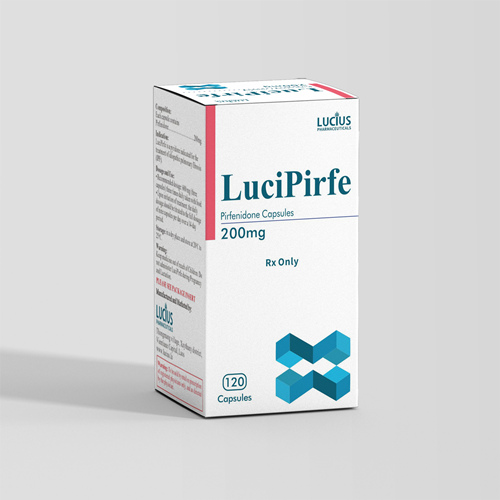Detailed Explanation of the Efficacy and Role of Pirfenidone: From Mechanism to Clinical Application

Detailed Explanation of the Efficacy and Role of Pirfenidone: From Mechanism to Clinical Application
For patients with idiopathic pulmonary fibrosis (IPF), Pirfenidone is a drug that has attracted much attention during the treatment process. This antifibrotic agent can inhibit the fibrotic process in lung tissue, bringing new treatment possibilities for patients. However, its cost is a significant financial burden for many patients. When considering its use, it is crucial to fully understand its efficacy and functions. Next, we will delve into the specific performance and application key points of Pirfenidone in treatment.
I. Basic Introduction to Pirfenidone
Pirfenidone is an oral medication that has been listed as an "essential medicine" by the World Health Organization and is specifically used for the treatment of idiopathic pulmonary fibrosis. Idiopathic pulmonary fibrosis is a chronic and progressive lung disease that causes lung tissue to gradually harden and scar, affecting respiratory function. Pirfenidone effectively slows down and improves patients' symptoms by suppressing the inflammatory response during the fibrotic process and reducing the formation of fibrous tissue. The drug is usually taken orally three times a day, with common dosages of 801mg and 267mg, and its therapeutic effects have been verified in multiple clinical trials.
II. Mechanism of Action of Pirfenidone
Pirfenidone exerts its effects mainly by regulating the expression of cytokines, growth factors, and fibrosis-related proteins. Among them, transforming growth factor-beta (TGF-β) plays a crucial role in the process of pulmonary fibrosis. It can promote the proliferation of fibroblasts and the synthesis of fibrin. Pirfenidone, however, can inhibit the expression of TGF-β, reduce the number of fibroblasts, and decrease fibrin synthesis, fundamentally slowing down the progression of the disease. In addition, Pirfenidone also has antioxidant and anti-inflammatory properties, which can alleviate the damage of inflammation to lung tissue and further protect lung function.
III. Clinical Efficacy of Pirfenidone
Numerous clinical trial results show that Pirfenidone has a significant therapeutic effect on idiopathic pulmonary fibrosis. Compared with patients taking a placebo, those treated with Pirfenidone experience a significantly slower decline in lung function, with relieved symptoms such as cough and shortness of breath, and a notable improvement in quality of life. These clinical data indicate that Pirfenidone has become an important part of the treatment plan for idiopathic pulmonary fibrosis, providing strong support for patients to control the disease and extend their survival period.
IV. Adverse Reactions of Pirfenidone
Although Pirfenidone has a remarkable therapeutic effect in treating idiopathic pulmonary fibrosis, some adverse reactions may occur during its use. Common ones include gastrointestinal discomfort symptoms such as nausea, vomiting, and loss of appetite, and some patients may also experience mild to moderate long-term elevation of liver enzymes. In rare cases, severe liver function damage may even occur. Therefore, during the period of taking Pirfenidone, patients need to closely monitor their liver function and undergo regular relevant examinations. Once any abnormalities are found, they should communicate with their doctors in a timely manner to adjust the treatment plan. If necessary, you can consult Dingxiang customer service for more professional advice.
Case Q&A
Q: I often feel nauseous after taking Pirfenidone, which affects my normal diet. What should I do?
A: Nausea is a common adverse reaction of Pirfenidone. It is recommended that you try adjusting the time of taking the medicine, such as taking it after meals, to reduce the irritation of the drug to the stomach and intestines. You can also evenly distribute the three daily doses throughout the day to avoid taking too much medicine at one time. If the nausea persists and is severe enough to affect daily life, you should inform your attending doctor in a timely manner. The doctor may adjust the dosage or provide medications to relieve the symptoms according to the situation. If you have any questions, you can also consult Dingxiang customer service.
Q: During the period of taking Pirfenidone, the liver function test showed elevated liver enzymes. Can I continue to take the medicine?
A: Elevated liver enzymes require attention. For mild elevation, the doctor may suggest close observation, along with appropriate dosage adjustment or more frequent liver function monitoring. However, if the elevation of liver enzymes is significant, or other symptoms of abnormal liver function occur, it may be necessary to temporarily stop the medication and conduct further examination and evaluation. The specific treatment method must follow the doctor's professional guidance. If necessary, you can consult Dingxiang customer service for more information.
Pirfenidone brings new treatment hopes to patients with idiopathic pulmonary fibrosis with its unique mechanism of action and proven clinical efficacy. Although there may be some adverse reactions during use, through reasonable monitoring and response, patients can better utilize the therapeutic effects of the drug. During the treatment process, maintaining close communication with doctors and consulting professionals when necessary will help patients use Pirfenidone more safely and effectively.次
